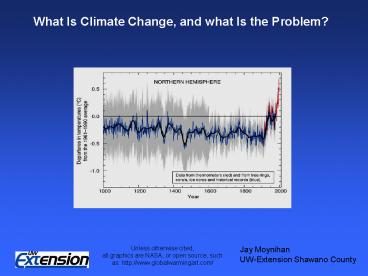What Is Climate Change, and what Is the Problem? PowerPoint PPT Presentation
1 / 21
Title: What Is Climate Change, and what Is the Problem?
1
What Is Climate Change, and what Is the Problem?
Jay Moynihan UW-Extension Shawano County
Unless otherwise cited, all graphics are NASA,
or open source, such as http//www.globalwarminga
rt.com/
2
Climate Change
- Is not new. The climates on earth have always
slowly changed over long periods of time. - Is not the Greenhouse Effect, though that is
important to it. - The problem we have, is rapid climate change.
3
The Greenhouse Effect
4
Carbon dioxide important for retaining heat in
the atmosphere.
The amount of CO2 in the atmosphere has varied
over time
5
In the early 1960s NASA sent probes to Venus and
Mars
6
We came upon the Goldilocks Problem
Lead would melt on the surface. Atmosphere 93x
thicker than ours, and made of CO2
Atmosphere 95 CO2, but less than 1 as thick as
ours Cold
Just Right!
7
The reason earth is just right is the way our
planets carbon cycle works.
8
A complex dynamic inter-relationship of geology,
chemistry, and biology, all in relation to energy
from the sun creates and maintains what we call
climate.
9
http//www.globalchange.umich.edu
10
Lets zoom in on the geology part for a bit.
- A molecule of CO2 deposits in the oceans after
about 100 years of rolling around in plants,
animals, and the atmosphere. - Some carbon from dead plants and animals get
covered over, eventually. - It slowly gets crunched down in the earths
crust. - From that, you get
- Carbonate rocks
- Oil
- Natural gas
- Coal
- Diamonds
11
In the early 1700s we learned to do something
really amazing.
We figured out how to get that old carbon out of
the ground, nearly completely processed by
geology for burning, to do work!
12
But burning that old buried carbon (hundreds of
millions of years worth), pumped new CO2 into the
carbon cycle.
13
So
14
Climate models predicted the first extreme signs
of warming would be in the Northern Circumpolar
region
Alaska
15
Melting permafrost, street collapse
Sudden collapse of permafrost redirects river
through a highway
Drunken Trees
Invasion of the Spruce Bore Beetle
ALASKA NOW
16
As of August 9, 2007 Scientific models re ice
melt in arctic as of 02/2007, are at current
observed rate, too slow.
Image is from http//www.usgcrp.gov/usgcrp/Library
/nationalassessment/LargerImages/RegionGraphics/Al
aska/SeaIce.jpg
DOD images
17
Shows the timescales over which emitted carbon
dioxide is removed from the atmosphere. Mixing in
the biosphere and oceans remove 70-85 of
emissions after 200 years, but the remainder
establishes a new equilibrium that may persist
for hundreds of thousands of years.
18
(No Transcript)
19
So, what difference does a few degrees centigrade
change in the average planetary annual
temperature make?
Well. About 72,000 years ago, the average
planetary annual temperature slide down about 3
degrees centigrade (thats 5.4 degrees F.) And
this is what happened
20
Wisconsin Glaciation (Ice Age) 70,000 18,000 BC
21
SummaryThe balance of the carbon cycle, which
regulates the greenhouse effect has been
disrupted by the injection of carbon dioxide by
us into the system.The system balances the
books over a long time span. Our new deposit is
really fast.It is getting warmer and it is
compared to normal, rapid
Images graphics were used from The IPCC, U.S.
Department of Defense, NASA, Nelson Institute
(UW), and Creative Commons public domain climate
change image banks, and http//www.globalwarmingar
t.com

